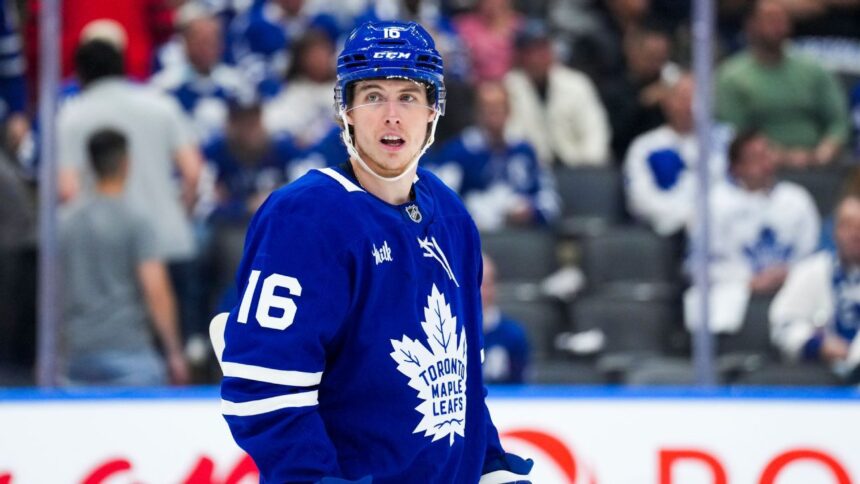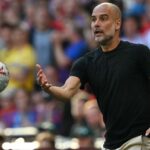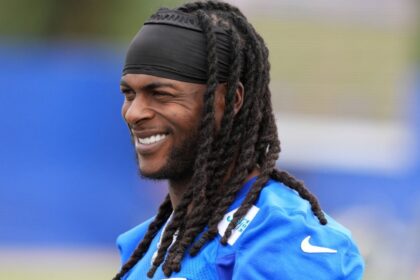The 2024-25 NHL regular season has concluded, and the playoffs are already underway. It’s time to analyze what the postseason holds for the teams that didn’t make it. What moves will these teams make in free agency, trades, and the draft? How much will they improve for the 2025-26 season?
Below, an analysis of what went wrong for each eliminated team, along with the key aspects of the offseason and realistic expectations for next season. More teams will be added to this analysis as they are eliminated.
Note: The profiles of the teams in the Atlantic and Metropolitan Divisions were written by Kristen Shilton, while Ryan S. Clark analyzed the teams in the Central and Pacific Divisions. Statistics were obtained from sites such as Natural Stat Trick and Evolving Hockey. Projected salary cap space is based on PuckPedia. The dates indicated with each team correspond to the original publication. Teams are listed alphabetically by publication date.
Eliminated Teams and Offseason Analysis
Toronto Maple Leafs (May 18)
Projected salary space: $27.49 million
2025 Draft Selections: 2nd (FLA), 3rd (EDM), 5th, 5th (PIT), 6th, 7th
What went well? The Maple Leafs had another outstanding regular season. Toronto won its first division title in 25 years, finishing fourth overall in points (108) and showcasing the seventh-best offense (3.26 goals per game). First-year coach Craig Berube transformed the Leafs into a team capable of not only scoring goals, but also playing a solid collective defensive game, resulting in the league’s eighth-best defense (2.79 goals against).
The goaltending duo of Anthony Stolarz (21-8-3, .926 save percentage, 2.14 goals against average) and Joseph Woll (27-14-1, .909 SP, 2.73 GAA) worked perfectly. In addition, the new additions on defense, especially Chris Tanev, made the Maple Leafs physically stronger than in previous years.
The Leafs also received unexpectedly solid contributions from familiar faces, including John Tavares; the veteran had one of his most productive seasons for Toronto, with 38 goals and 74 points. And rising star Matthew Knies had a breakout season with 29 goals and 58 points, a success he carried over into the postseason, with several strong performances. Speaking of which, the Leafs won a playoff round!
What went wrong? Toronto could have overcome the Ottawa Senators with a win in the first round, but the Leafs’ postseason demons were present in their second-round matchup with the Florida Panthers.
Toronto squandered an initial 2-0 series lead, watching it evaporate in Florida’s Game 3 victory and the shutout win in Game 4. The Leafs were booed on their home ice in the Game 5 thrashing, 6-1, where Toronto’s lack of star power was glaringly obvious. Auston Matthews, Mitch Marner, and William Nylander had not scored goals against the Panthers to that point, but rose to the occasion in Game 6 to drag the Cats back to Toronto for Game 7.
That’s where the Leafs’ streak ended, marking Toronto’s sixth Game 7 loss in the Matthews era. Florida is designed to wear down its opponents, and while Toronto enthusiastically blocked shots throughout the series, the Panthers’ strong pressure and good play in front of a solid Sergei Bobrovsky were too much to overcome. Toronto’s once-potent power play didn’t help either, going 2-for-20 in the series.
It’s true that the Leafs lost Stolarz in the first game of the series to an undisclosed injury, but Woll gave them every chance to win Game 4, was strong early in Game 5, and shut the door completely in Game 6. The Leafs simply couldn’t produce offensively and, as is customary, their best skaters didn’t show up when it mattered. Berube said Toronto was “thinking too much” late in the postseason. That may have been true, and once again, there’s another long summer ahead to reflect on what might have been.
Keys for the offseason: First things first: Is Marner still a Maple Leaf next season? The unrestricted free agent who is about to finish his contract wanted to play the last year of his contract before deciding whether to recommit to Toronto. It’s time for both sides to decide whether renewing their vows, or an amicable split, makes the most sense.
The Leafs will have space under the salary cap to use on a significant extension, but depending on where Marner expects to land (likely among the league’s highest-paid forwards), Toronto will have to balance his price with their other needs. Knies is a restricted free agent the Leafs will want to invest in, and Tavares’ contract also expires. Given their performance this season, there must be interest on both sides in staying together.
There’s also the matter of Nicholas Robertson, another pending RFA who has expressed a desire to leave Toronto in the past. Will general manager Brad Treliving find a suitable trade partner now?
The Leafs don’t have much draft capital, as they traded their first-round pick this season for Jake McCabe in 2023, but the cap space they have will be useful in the open market, and Robertson could also come into play as a bargaining chip.
Realistic Expectations for 2025-26: Toronto is built to win now, and the team will again contend for a division title next season. Will it lead to anything noteworthy in the playoffs? Well, it’s easy to wonder what it will take for that to be a reality.
Winnipeg Jets (May 17)
Projected salary space: $36.36 million
2025 Draft Selections: 1st, 3rd, 5th, 6th, 7th
What went well? Any questions about what Scott Arniel’s first season as head coach would look like after having been Rick Bowness’s assistant were answered emphatically. Especially with the Jets accomplishing something they hadn’t done since the 2020-21 season: advancing to the second round of the playoffs.
Much of their success came from being able to trust that they could get contributions from their entire lineup. This was reinforced by having a consistent defensive structure that was enhanced by Connor Hellebuyck, who is on his way to becoming the first American to win three Vezina Trophies.
What went wrong? There was never any concern about whether the Jets were a playoff team. But there were questions about how the Jets would fare against a team in a legitimate championship window if they got past the first round.
Facing the Dallas Stars provided glimpses that the Jets could keep games close for a while, before succumbing to the big period against one of the West’s top contenders. It’s what happened in Games 1 and 3, when the Stars had a pair of three-goal periods in those encounters. Or it was watching key players like Mikael Granlund and Mikko Rantanen set the pace for the Stars with hat tricks and the Jets not getting the same high-octane offense.
Keys for the offseason: The Jets are going to have a lot of money this summer to address their roster.
Some of that will likely go toward re-signing pending restricted free agent Gabriel Vilardi, who just had his third straight 20-goal campaign by scoring a career-high 61 points.
Where it gets complicated, interesting, or both is figuring out how they’ll handle pending unrestricted free agent winger Nikolaj Ehlers. Does he stay? Does he go? If he goes, will they make a contract and trade and not risk losing him for nothing? And if he goes, how do the Jets replace a dynamic seven-time 20-goal scorer?
Realistic expectations for 2025-26: No team is guaranteed a playoff spot. But there are some that are judged more by what they did or didn’t do in the postseason compared to what they did in the regular season. That’s where the Jets currently live.
The Jets should aim for a playoff spot in a demanding Central Division. It’s just that their known difficulties in getting out of the first round are what makes the regular season, although important, not the barometer by which they will be evaluated. Whether or not they can get out of the first round, and the second, and beyond, will be the new acid test for the Jets.
Washington Capitals (May 15)
Projected salary space: $12.38 million
2025 Draft Selections: 1st, 2nd (BOS), 3rd (CAR), 4th, 5th
What went well? Washington was supposed to be rebuilding, and this season proved that the Capitals didn’t need much time to regroup. They were excellent from the start of the regular season and quickly rose to the top of the Eastern Conference standings. That’s where the Capitals stayed for most of the season, accumulating the second-most points (111) in the league thanks to their offense, which ranked second (averaging 3.49 goals per game) and the excellent goaltending of Logan Thompson (31-6-6, .910 SV%, 2.49 GAA).
However, there wasn’t a bigger, or better, story for the Capitals than seeing captain Alex Ovechkin make history when he surpassed Wayne Gretzky as the all-time leader in NHL goals with the 895th goal of his career on April 6. It was an individual achievement that Ovechkin pursued with his entire team; his teammates referenced that pursuit as a constant source of motivation through the ups and downs of their season.
In addition to the Capitals’ veterans’ display, the Capitals also saw tremendous growth from some other emerging stars, including Ovechkin’s frequent linemates, Aliaksei Protas (with a 30-goal campaign) and Dylan Strome (who led the club with 82 points). Coach Spencer Carbery deserves ample credit for turning the Capitals’ fortunes around in record time.
What went wrong? The Capitals’ greatest strength in the regular season became their biggest challenge in the playoffs. Washington’s high-flying offense began to dry up in their second-round series against Carolina, as the Hurricanes’ stout defense and outstanding goaltending stifled the Capitals’ attack.
Ovechkin was particularly absent from the scoresheet against Carolina, failing to appear on the board until he scored a power-play goal in Game 4. But Washington’s depth wasn’t the asset it could have been, as the team averaged just over two goals per game.
While Thompson did his best to keep the Hurricanes at bay, he didn’t receive enough support to turn those efforts into wins. The Capitals weren’t creating high-danger opportunities as they could in the regular season, and the lack of presence in front of the net made it too easy for Frederik Andersen to shut the door.
Meanwhile, Washington’s own defensive efforts never matched Carolina’s intensity, and the Hurricanes leaned on 10 different goalscorers for a more balanced offense than Washington deployed. Carolina also capitalized on a poor Capitals penalty kill (72.7%) to send them into an early summer.
Keys for the offseason: Washington is in a good position for a bright future. In the process of getting there, the Capitals will also likely say goodbye to some critical veteran presences from their past.
T.J. Oshie is an unrestricted free agent pending after missing the entire 2024-25 season with a chronic back issue. The same goes for Nicklas Backstrom, who missed the entire campaign with a hip injury. With those skaters off the books, the Capitals will be able to restock in the open market and should target top-nine skaters to help avoid getting offensively bogged down in the postseason again.
The Capitals also have other veterans with expiring contracts, namely Lars Eller and Anthony Beauvillier, who have been role players in what was a strong season. Washington can also do some damage in the draft, either through trades or by using the picks, with selections in the first five rounds. Then, of course, there’s the question of Ovechkin: is he done now after that historic achievement? Or is there another year ahead for him in the NHL? He has one year left on his contract.
Realistic expectations for 2025-26: Washington may need some offensive improvements, but it’s not so drastic as to prevent them from being a playoff team again. Expect to see them trending in a similar direction, towards the top of the Metropolitan standings, next season.
Vegas Golden Knights (May 14)
Projected salary space: $9.62 million
2025 Draft Selections: 2nd, 3rd (WSH), 4th, 5th, 6th, 6th (WSH)
What went well? Despite all the concerns about how much they lost in free agency last summer, the Golden Knights found solutions. Local talent Pavel Dorofeyev led them in goals in the regular season (35), and others like Brett Howden had breakout campaigns.
Many of those contributions, along with what they received from their stars and other venerable figures, allowed the Golden Knights to remain in the category of teams that could challenge for the Stanley Cup. Their depth was certainly on display against the Minnesota Wild in the first round.
What went wrong? In the second round against the Oilers, that depth disappeared. They arrived at game five trying to find the kind of answers that eluded them throughout the series.
Players like Ivan Barbashev, Tomas Hertl, and Howden combined to score 78 goals in the regular season, but they didn’t score any in the series against Edmonton. Their defensemen combined for 35 goals during the regular season, but only had one in the playoffs.
The lack of consistent annotations was fundamental in the series, particularly in the games in which the Golden Knights scored the first goal in an attempt to take control, only to see the series slip away from their hands.
Keys for the offseason: The upcoming offseason will see the Golden Knights facing some important questions: Franchise center Jack Eichel’s current contract runs through the 2025-26 season, while Mark Stone, Alex Pietrangelo, and William Karlsson’s contracts run through the 2026-27 season.
But for now, they have 16 players under contract for next season, and Brandon Saad and Reilly Smith are part of a class of six unrestricted free agents. Nicolas Hague is their key restricted free agent; he has one year of team control remaining before reaching UFA status.
It’s possible the Golden Knights use their cap space to add on the margins, while trying to secure a deal with Hague that works for both sides before what’s expected to be a busy 2025-26 campaign.
Realistic expectations for 2025-26: The demand, as always, for a franchise that has made winning at all costs its hallmark, is to challenge for the Stanley Cup.
But that comes with the caveat that this upcoming season could have two major roster-building issues: Eichel and Dorofeyev. As noted, Eichel is entering the final year of a contract that earns him $10 million annually. As for Dorofeyev, replicating or surpassing the career-high 35 goals he scored this season could make him command a new contract; he will be a pending RFA who is slated to earn $1.835 million in 2025-26. Finding long-term solutions to both situations will be critical.
St. Louis Blues (May 4)
Projected salary space: $7.15 million
2025 Draft Selections: 1st, 5th, 6th
What went well? Every move GM Doug Armstrong made during the summer and in the season.
The qualifying offers for Philip Broberg and Dylan Holloway led to Broberg, when healthy, having a career-high eight goals and 29 points while logging over 20 minutes per game. Not to be outdone, Holloway had his first 20-goal campaign.
Cam Fowler’s transfer resulted in him having one of the strongest seasons of his career, and he led the team in scoring for much of the first round.
Going from Drew Bannister to hiring Jim Montgomery resulted in the Blues gaining a legitimate level of consistency that they used to make the playoffs for the first time since the 2021-22 season.
What went wrong? Part of the problem was that the Blues could never win a game at the Canada Life Centre. The rest is because the Blues had a proven plan that worked twice but couldn’t be replicated two more times to win the series against the Winnipeg Jets.
Generating a total of 20 high-danger scoring chances in Games 3 and 4 was critical to the Blues scoring 11 goals against Connor Hellebuyck in those contests. That created the belief that the Blues could capitalize on the struggles of one of the best goaltenders of his era, whose regular season success had yet to translate to the playoffs. But Hellebuyck and the Jets would find a counterpunch en route to advancing to the second round.
Keys for the offseason: To begin, the Blues don’t have much cap space. But they only have one restricted free agent pending in goaltender Joel Hofer, while center Radek Faksa and defenseman Ryan Suter are their only unrestricted free agents pending.
Then there is the situation of Torey Krug. He missed the entire regular season and playoffs after undergoing ankle surgery in the preseason. Getting Krug back would not only give the Blues a logjam of defensemen, but it would give them six defensemen under contract earning more than $4 million annually, and all of them, except Broberg, have some form of trade protection.
Realistic expectations for 2025-26: Making the playoffs again, or at least remaining in the hunt for a playoff spot until the end of the season, is the plan. The Central Division will still have teams like the Avalanche and Stars who are in a championship window, with the Jets trying to establish themselves as a perennial threat.
Meanwhile, the Wild are expected to be an active player in free agency, while the same could be said of Utah after it stayed in contention for a wild card spot entering the final two weeks of the season. Adding the Blues to that equation means there will be six teams (at a minimum) in the division legitimately vying for a playoff spot in 2025-26.
Colorado Avalanche (May 3)
Projected Salary Space: $8.70 million
2025 Draft Selections: 4th (VAN), 7th
What went well? Adjustments and course corrections. In December, the Avalanche already had concerns about their supporting cast, along with the problems created by an inconsistent goaltending duo.
That led Avs general manager Chris MacFarland to make a series of trades that saw Colorado do everything from getting a new tandem in net, led by Mackenzie Blackwood, to making key additions at the trade deadline to make the Avs one of the most dangerous teams heading into the playoffs. Their first-round exit came at the hands of a team looking to make their third straight conference finals appearance.
What went wrong? The margins for error were razor-thin. Then again, that was probably the case in a first-round matchup of two teams clearly in a championship window, and both finished with over 100 points in the regular season.
Opening the series against the Dallas Stars with a 5-1 victory and taking game 4 with a 4-0 win spoke to how dominant the Avs could be against another Stanley Cup contender.
But the overtime wins the Stars had in games 2 and 3 were the difference between the Avs sweeping the series or, in this case, being eliminated in seven after an impressive game 6 win. They even led 2-0 in game 7, only to witness a historic third period from former teammate Mikko Rantanen.
Keys for the offseason: Determining the best way to spend their limited salary cap dollars is the task facing every team in a championship window. The Avalanche know this reality all too well, with the most important factor being Gabriel Landeskog’s health. While his return provides the Avs with a top-six forward, his $7 million cap hit cannot be moved to long-term injured reserve to create financial flexibility as the team had done in recent years.
That leaves the Avs with a projected cap space of $8.70 million to address a seven-player unrestricted free agent class that includes Jonathan Drouin and trade deadline additions Ryan Lindgren and Brock Nelson.
Realistic Expectations for 2025-26: They are still expected to remain among the top contenders who will fight for the Stanley Cup. The Avs have their core and quite a few members of their supporting cast under contract at least until next season. What they do in the offseason will play a role in complementing what they already have, with the idea that they will be among that handful of Western Conference teams that feel the title is within their reach.
Los Angeles Kings (May 1)
Proyect








